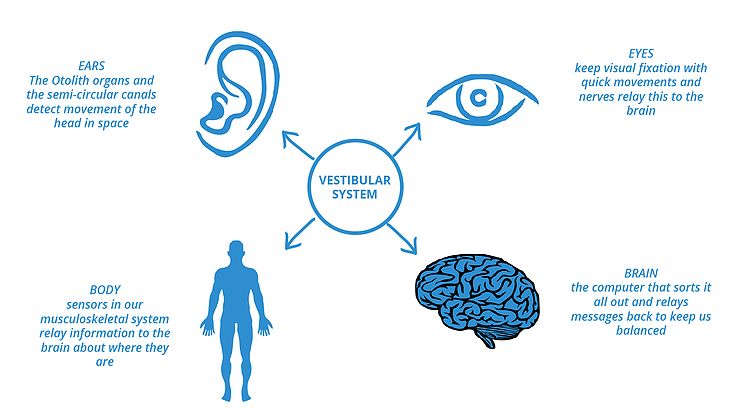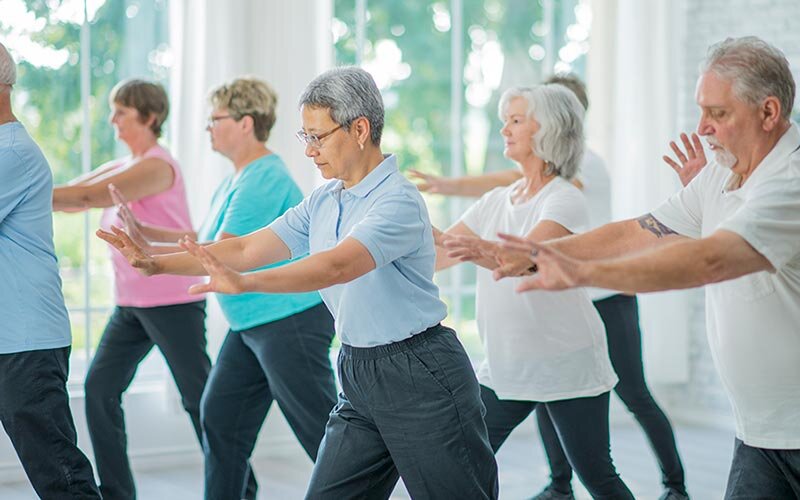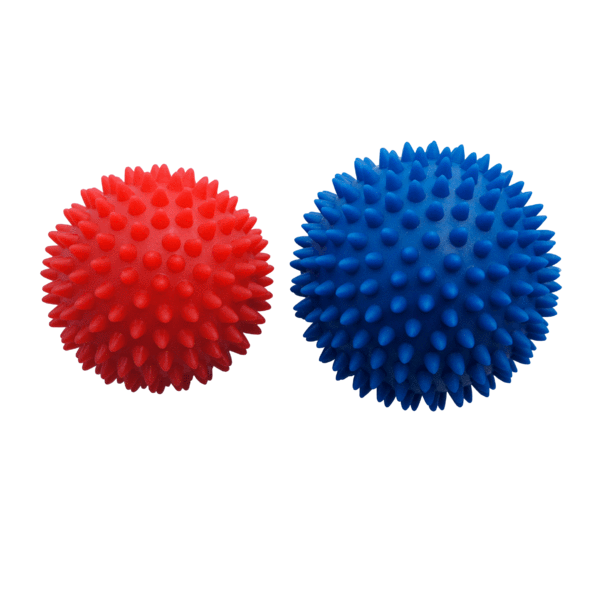Vestibular Disorders: How to Improve Balance & Decrease Fall Risk

The vestibular system in our body determines our sense of balance and eye motion. The system includes our inner ears and brain regions that process sensory information and spatial orientation. The root word “vestibule” is used in reference to an entrance, specifically, that of the inner ear.
Vestibular disorders can cause great distress and moodiness in sufferers, in addition to its profound impact on movement. Some sufferers may be surprised to discover the source of their discomfort situated within the vestibular system.
Fortunately, greater awareness of the condition is being circulated and more healthcare practitioners can identify the symptoms of a vestibular malfunction. Through specialized treatment and rehabilitation, sufferers can regain control over their senses to live the best quality of life.
Common Signs of Vestibular Disorders
Although vestibular disorders come in many forms, they may share common symptoms including the following:
• Dizziness
• Hearing difficulties
• Balancing problems during standing and/or movement
• Compromised eyesight
• Cognitive and psychological disturbances
Anxiety and psychological symptoms are a commonly overlooked complication of vestibular diseases. This is often caused by the distress from a distorted sense of reality - that compromises movement and hearing. Sufferers may feel depressed
Types of Vestibular Disorders
Vestibular disorders may be a result of age, injury, disease, environmental factors or even genetics. There are many types of vestibular disorders, which produce similar symptoms.
Acoustic Neuroma
Acoustic Neuroma, also known as vestibular schwannoma, is a slow-growing benign tumor that is located on the nerve that connects the inner ear to the brain. The tumor affects neuronal signals conveyed to the brain, which leads to vestibular problems such as motion instability and dizziness.
Common symptoms of the condition include ringing in the affected ear, facial numbness and hearing difficulties. Acoustic Neuroma is believed to be caused by the malfunction of a gene in chromosome 22, which is responsible for the suppression of tumors formed by Schwann cells that line the vestibular nerve.
Ménière's Disease
A disease caused by the build-up of fluid in the inner ear. Common symptoms include vertigo (dizziness that makes you feel like the world is spinning). The gradual fluid build-up in the inner ear eventually interferes with communication between the sensory nerves and receptors found in the brain. Hearing impairment may become permanent when left untreated due to the damage of the vestibular nerve.
Some possible causes of fluid build-up include viral infections, sports injuries, and allergic reactions
Perilymphatic Fistula (PLF)
Perilymph Fistula occurs when there is a rip/tear or biological defect of the membrane that separates your inner ear (labyrinth) from the middle ear. The inner ear contains a fluid known as perilymph, which is responsible for. The middle ear, however, is filled with air. Damage to the barrier between the ear parts leads to pressure changes (as some of the perilymphatic fluid leaks into the middle ear), which causes vestibular problems such as hearing difficulties and dizziness.
These are just three of the more common variants of vestibular disorders. There is a wide range of other conditions that lead to vestibular dysfunction, conditions such as ototoxicity, Benign paroxysmal positional vertigo (BPPV),
It is necessary to consult a healthcare professional toward identifying the specific type of vestibular disorder that you’re facing to receive proper treatment.
Treatment Options
Treatment options for vestibular disorders vary according to each specific diagnosis. Other factors include age, medical history and the general state of health. Treatment may range from home-based exercises and dietary changes to invasive surgical procedures that stabilize inner ear function.
Vestibular rehabilitation or VRT is a popular treatment method for various vestibular disorders. The method focuses on alleviating the physical symptoms (such as dizziness and vertigo) through a series of exercise-based programs. Its main idea revolves around the human brain's ability to refocus on other sensory channels (such as proprioception), thereby compensating for damaged or faulty vestibular systems.
Vestibular Disorders and Balance
Causes of vestibule disorders, such as multiple sclerosis, impede the function of our peripheral and central nervous systems. This disrupts the sensory process between nerve receptors and the brain, which destabilizes movement and the perception of balance. The vestibular system, vision and our sense of touch are three major factors that determine our movement stability. Through specialized exercises, we can improve body control to overcome the challenges of various mobility-affecting conditions.
The foot is often overlooked as the only contact point between the ground and our bodies. The soles of our feet are critical toward how we react to environments during movement. By addressing vestibular disorders from the feet up, sufferers can strengthen their overall balance and reduce the risks of falls.
Fall Prevention
Specialized products and treatments can help sufferers stabilize their movements and improve spatial awareness, which reduces the risks of falling due to a vestibular disorder. Falls remain a global health concern. According to the World Health Organization, falls are the second leading cause of accidental or unintentional injury deaths worldwide.
Vestibular disorders cause dizziness and a range of other symptoms that may increase the risk of falls. The human body maintains balance through three channels: vision, the vestibular system, and proprioception (through the sense of touch via nerve endings located on the spine and feet).
Keeping a close check on all three sensory channels will minimize the chances of falls and the incorporation of all these sensory input systems has been shown to effectively improve balance to help reduce falls.

Tip #1 - Balance Training
Tai Chi
The art of Tai Chi originates from ancient China and has remained popular in modern times. Tai Chi is a gentle process that involves 24- forms and 108 moves, each providing the right amount of pressure to strengthen muscles without causing strain. The exercise is also known to simulate blood circulation throughout the body. As Tai Chi promotes greater bodily control and awareness, it has been recommended by physiotherapists as part of fall rehabilitation therapies.
Yoga
Another ancient art form that is known to reconfigure movement control. Tai Chi and Yoga involve breathing techniques and well-paced physical steps that raises overall wellness through improved posture and vision. Additionally, these exercises reinforce the somatosensory system, specifically the trunk of the body for improved control over gait, standing and turning. This minimizes the chances of falling from bouts of vertigo or dizziness.

Tip #2 - Sensory Stimulation
WHOLE BODY VIBRATION
Power plate are devices that provide stability training by stimulating the nervous system with multi-directional vibrations. The technology was originally meant for Russian astronauts as a means of maneuvering the weightlessness of space.The device may initially prove to be a challenge for individuals who face severe vestibular issues but the beginner user can begin by sitting down and simply placing the feet on the Power Plate. Users undergo progressive conditioning to maintain balance with greater strength and consistency.
SENSORY-STIMULATING INSOLES
Naboso Technology's range of sensory insoles is specially developed to improve balance by restoring natural abilities from the ground up. Each Naboso sole functions through 2-point discrimination. The surface of Naboso Insoles is covered with tiny pyramid ridges which are evenly spaced out according to the natural distance between nerve receptors found on your feet. The concept is similar to interacting with braille, where nerve receptors are stimulated through direct contact with a textured surface.
Naboso's insoles are conveniently integrated into existing rehabilitation programs and may be customized to accommodate feet of all shapes and sizes.
RHINO PRO TEXTURED. BALL
The textured ball functions through tactile and texture stimulation. Users can benefit from the sensory stimulation of the hand by simply holding the Rhino Pro while walking or doing balance exercises. The skin of the hand is the like the skin of the feet which means that it plays a role in balance and stability.

Tip #3 - Eye Movement Exercises
Our eyes are designed to move and accommodate for light, providing us with as much sensory detail about our environment as possible. A decrease in visual acuity has been associated with impaired balance and delayed accuracy in motor patterns.
A 2018 study by Herbert et al. demonstrated the efficacy in the integration of eye movement exercises and visual stimulation in improving balance for those with MS. The study that focused on the BEEMS (balance and eye motion exercises for MS) integrated the following exercises for improved sensory integration and brain balancing.
More specific eye movement exercises can be see HERE